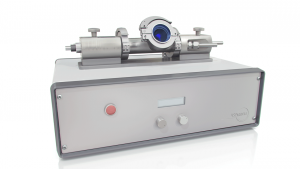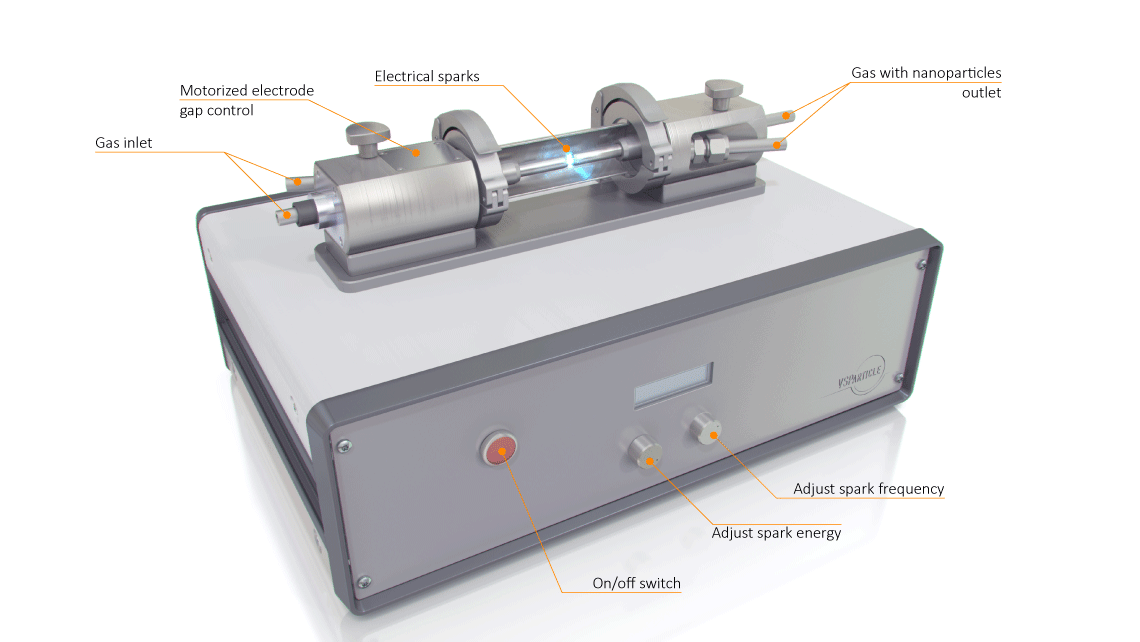VSP-G1 User Manual: Difference between revisions
No edit summary |
|||
| Line 9: | Line 9: | ||
== Introduction == | == Introduction == | ||
[https://docs.vsparticle.com/w/index.php/G1_User_Manual''top''] | [https://docs.vsparticle.com/w/index.php/G1_User_Manual''top'']<br> | ||
[[Image:Generator_One.png|thumb|left|VSParticle Generator One|''VSParticle Generator One'']] | |||
[[Image:Generator_One.png| | '''''(note about text of introduction... refine this when done with the rest of the manual content and when talking about features, try to link to them appropriately in the manual. For example, when talking about adjusting for particle size, link to the protocol for that)''''' | ||
Congratulations on your purchase of the VSParticle Generator One (VSP-G1). With the VSP-G1, easy production of inorganic nanoparticles from conductive materials is possible with control over size (1 atom to 20 nm) and production rate (xx – xx). | Congratulations on your purchase of the VSParticle Generator One (VSP-G1). With the VSP-G1, easy production of inorganic nanoparticles from conductive materials is possible with control over size (1 atom to 20 nm) and production rate (xx – xx). | ||
Revision as of 14:19, 8 September 2016
This is the comprehensive User Manual for the VSParticle Generator One unit. The Quick Start Guide is available as a quick reference for standard operation of the G1 unit.

VSParticle
Molengraafssingel, 10
2629 Delft
The Netherlands
info@vsparticle.com
www.vsparticle.com
Introduction

(note about text of introduction... refine this when done with the rest of the manual content and when talking about features, try to link to them appropriately in the manual. For example, when talking about adjusting for particle size, link to the protocol for that)
Congratulations on your purchase of the VSParticle Generator One (VSP-G1). With the VSP-G1, easy production of inorganic nanoparticles from conductive materials is possible with control over size (1 atom to 20 nm) and production rate (xx – xx).
Designed for use by researchers studying material properties, the VSP-G1 allows flexibility in the use of different gases and electrode materials for a wider range of combinations. The closed system provides a safer production of nanoparticles and can easily be dismantled for safe transport of produced nanoparticles as well as for system cleaning and maintenance. The VSP-G1 system can be integrated into a larger system for more complex operating procedures.
The production rate depends on the energy input into the spark, and material properties of the electrode. The VSP-G1 operates up to 60W, which corresponds to ablation rates up to ~100 mg/h for e.g. Au. Particle size is a function of the production rate and the flow rate. The spark gap is controlled automatically, allowing continuous operation. The spark generator is designed for a broad operating window, making it suitable for applications ranging from cluster research to materials science.
User service is needed in two situations: Periodic cleaning and replacing of electrodes. In both activities can be performed with a safe, simple and fast (<20 mins) protocol.
The particles are made available as an aerosol, allowing the user to choose a suitable deposition method for his or her substrates. VSParticle can help select/develop a deposition system fitted to your specific needs.
(work in somehow)
Features of the VSP-G1:
- Electrodes can be replaced by user (requires opening and cleaning of reactor).
- Mixing materials at the nanoscale by using electrodes of different materials.
- High purity: Exposes materials: Stainless steel, PTFE, Viton. No polymers near ablation zone. Gas based production eliminates the need for chemicals/surfactants or precursors.
- The output of the system consist out of gas stream filled with particles. There are no polluting by-products formed during production.
- The reactor can easily be customized to allow cross flow, co-flow, through flow (standard) and combined configurations.
How to use this manual
This user manual provides instructions for the set-up, installation, operation and maintenance of a VSP-G1 unit. Before operating the VSP-G1 unit, please read the manual with careful attention to the safety section and to the warnings provided throughout the manual, indicated by the following symbols:
(symbols used in the manual)
| (Short index of manual and a 1 sentence summary of each chapter/section) |
A quick start guide is also included for faster set-up as part of the standard operating procedure. For more information regarding safety and more complex operations as well as troubleshooting and maintenance, please refer to this manual.
Safety
Warning of residual risks
Protective measures
Airborne noise emissions
Foreseeable misuse
Setting up
Intended use
Foreseeable misuse
Workstation
Assembly, installation and connection

Stability conditions
Safe transportation, handling and storage
Operations
Instructions for putting into service and use of the G1 unit
What to do in the case of accident, breakdown or likely blockage
Description of adjustment and maintenance operations and preventive maintenance measures
Instructions to enable safe adjustment and maintenance, including protective measures
Maintenance and Troubleshooting
Error messages and how to resolve them
Possible issues and how to resolve them
Maintenance checklist (before and after normal use)
Maintenance checklist (periodical/occasional throughout product lifetime)
Accessories and Parts Replacement
Tools fitted to G1
Spare parts
Appendices
Detailed communication set up
Detailed specifications not otherwise indicated in manual
Conceptual design and manufacturing drawings and schemes of components, sub-assemblies, circuits, etc.
Descriptions and explanations necessary for the understanding of ˄˄ and operation of electrical equipment
EC Declaration of Conformity
Warranty
Edited by Kate Groves 15:58, 8 September 2016 (CEST)
